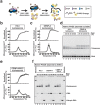Crystal structure and stable property of the cancer-associated heterotypic nucleosome containing CENP-A and H3.3
- PMID: 25408271
- PMCID: PMC4236741
- DOI: 10.1038/srep07115
Crystal structure and stable property of the cancer-associated heterotypic nucleosome containing CENP-A and H3.3
Abstract
The centromere-specific histone H3 variant, CENP-A, is overexpressed in particular aggressive cancer cells, where it can be mislocalized ectopically in the form of heterotypic nucleosomes containing H3.3. In the present study, we report the crystal structure of the heterotypic CENP-A/H3.3 particle and reveal its "hybrid structure", in which the physical characteristics of CENP-A and H3.3 are conserved independently within the same particle. The CENP-A/H3.3 nucleosome forms an unexpectedly stable structure as compared to the CENP-A nucleosome, and allows the binding of the essential centromeric protein, CENP-C, which is ectopically mislocalized in the chromosomes of CENP-A overexpressing cells.
Figures





References
-
- Luger K., Mäder A. W., Richmond R. K., Sargent D. F. & Richmond T. J. Crystal structure of the nucleosome core particle at 2.8 Å resolution. Nature 389, 251–260 (1997). - PubMed
Publication types
MeSH terms
Substances
Associated data
- Actions
LinkOut - more resources
Full Text Sources
Other Literature Sources
Molecular Biology Databases

